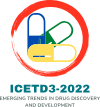Speaker
Description
The present investigation develops controlled release matrix type transdermal patches of diltiazem hydrochloride using natural and biodegradable polymer hydroxyl propyl methylcellulose. Any type of formulation that allows a drug substance to transit from outside of the skin through the layers of skin to underlying tissues and finally into the systemic circulation to exert a pharmacological action is called a transdermal drug delivery system. Dose of diltiazem hydrochloride 180-240 mg daily, melting point 210-215 $^{\circ}$C, and overall drug lipophilicity make the drug suitable for transdermal drug delivery system. Transdermal patches were prepared by film casting technique. 73.96 g of Diltiazem hydrochloride and HPMC in the ratio of 3%, 4%, and 5% were dissolved in ethanol and chloroform (1:1 mixture) and castor oil 30% w/w of polymer used as a plasticizer. The mixture was poured into a glass plate using a ring of 4.3 cm diameter having 5 mL capacity. After drying at room temperature for 24 h, circular film of 1 cm diameter (area of 0.785 cm$^{2}$) each containing 4 mg drug was cut. The prepared formulations were evaluated for their physical characteristics such as percentage moisture absorption, thickness, weight, and drug content. The physico-chemical evaluation data revealed that percentage moisture absorption is high in formulation F6 and low in formulation F2. Thickness and weight uniformity were in the range of 0.036±0.004 to 0.040±0.006mm and 0.024±0.005 to 0.045±0.003 mg, respectively. The drug content was found to be 90.3±0.050% to 93.1±0.071% in the prepared delivery system. In vitro drug release revealed that the formulation F1, F2, F3, F4, F5, and F6 releases 77.05%, 73.22%, 68.59%, 67.07%, 59% 48.41% of the loaded drug at the end of 24 h from the formulations, respectively. The formulation F5 containing 4% HPMC as drug reservoir of diltiazem hydrochloride and EC 5% as rate-controlling membrane has shown best release at the end of 24 h in a concentration-independent manner. In conclusion, formulation F5 achieved the targets of the present study, such as: Reducing the frequency of administration and no systemic side effects. Hence it may improve patient compliance.
